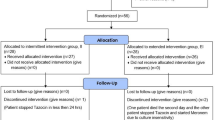Abstract
Emerging evidence suggests taurolidine reduces the risk of repeated episodes of catheter related blood stream infections (CRBSI) in a subgroup of patients receiving home parenteral nutrition (HPN). We defined 3 indications where taurolidine could be considered and retrospectively analysed data from patients who were treated over a 10 year period to examine the validity of these criteria. Twenty-two patients were identified from a total HPN population of 81, representing 33.2 years of experience. The overall CRBSI rate pre- and post-taurolidine usage was reduced from 5.71 to 0.99 infections per 1000 patient parenteral nutrition days (P-value <0.0001), with reductions identified in each smaller subgroup, confirming previous reports of a significant reduction in infections when taurolidine is used as secondary prophylaxis and providing initial data suggesting the benefit of its use as primary prophylaxis.
This is a preview of subscription content, access via your institution
Access options
Subscribe to this journal
Receive 12 print issues and online access
$259.00 per year
only $21.58 per issue
Buy this article
- Purchase on Springer Link
- Instant access to full article PDF
Prices may be subject to local taxes which are calculated during checkout
Similar content being viewed by others
References
Toure A, Lauverjat M, Peraldi C, Boncompain-Gerard M, Gelas P, Barnoud D et al. Taurolidine lock solution in the secondary prevention of central venous catheter-associated bloodstream infection in home parenteral nutritionpatients. Clin Nutr 2012; 31: 567–570.
Bisseling TM, Willems MC, Versleijen MW, Hendriks JC, Vissers RK, Wanten GJ . Taurolidine lock is highly effective in preventing catheter-related bloodstream infections in patients on home parenteral nutrition: a heparin-controlled prospective trial. Clin Nutr 2010; 29: 464–468.
Cullis PS, McKee RF . Taurolidine lock - experience from the West of Scotland. Clin Nutr 2011; 30: 399–400; author reply 1.
Santarpia L, Alfonsi L, Tiseo D, Creti R, Baldassarri L, Pasanisi F et al. Central venous catheter infections and antibiotic therapy during long-term home parenteral nutrition: an 11-year follow-up study. JPEN J Parenter Enteral Nutr 2010; 34: 254–262.
Ugur A, Marashdeh BH, Gottschalck I, Brobech Mortensen P, Staun M, Bekker Jeppesen P . Home parenteral nutrition in Denmark in the period from 1996 to 2001. Scand J Gastroenterol 2006; 41: 401–407.
Benoit JL, Carandang G, Sitrin M, Arnow PM . Intraluminal antibiotic treatment of central venous catheter infections in patients receiving parenteral nutrition at home. Clin Infect Dis 1995; 21: 1286–1288.
Fortun J, Grill F, Martin-Davila P, Blazquez J, Tato M, Sanchez-Corral J et al. Treatment of long-term intravascular catheter-related bacteraemia with antibiotic-lock therapy. J Antimicrob Chemother 2006; 58: 816–821.
Fernandez-Hidalgo N, Almirante B, Calleja R, Ruiz I, Planes AM, Rodriguez D et al. Antibiotic-lock therapy for long-term intravascular catheter-related bacteraemia: results of an open, non-comparative study. J Antimicrob Chemother 2006; 57: 1172–1180.
Author information
Authors and Affiliations
Corresponding author
Ethics declarations
Competing interests
The authors declare no conflict of interest.
Additional information
Contributors: JS conceived the study, carried out the study, data analysis and drafted the manuscript. MN carried out the study, data analysis and helped draft the manuscript. MN carried out the study, data analysis and helped draft the manuscript. ZL carried out data collection and helped draft the manuscript. CP carried out data analysis and performed statistical analysis. AK conceived the study, participated in its design and coordination and helped write the manuscript. TS conceived the study, participated in its design and coordination and helped write the manuscript. MS conceived the study, participated in its design and coordination and helped write the manuscript (guarantor of article). All authors approved the final version of the article including the authorship list.
Rights and permissions
About this article
Cite this article
Saunders, J., Naghibi, M., Leach, Z. et al. Taurolidine locks significantly reduce the incidence of catheter-related blood stream infections in high-risk patients on home parenteral nutrition. Eur J Clin Nutr 69, 282–284 (2015). https://doi.org/10.1038/ejcn.2014.32
Received:
Revised:
Accepted:
Published:
Issue Date:
DOI: https://doi.org/10.1038/ejcn.2014.32
This article is cited by
-
In vitro activity of taurolidine gel on bacteria associated with periodontitis
Clinical Oral Investigations (2016)



